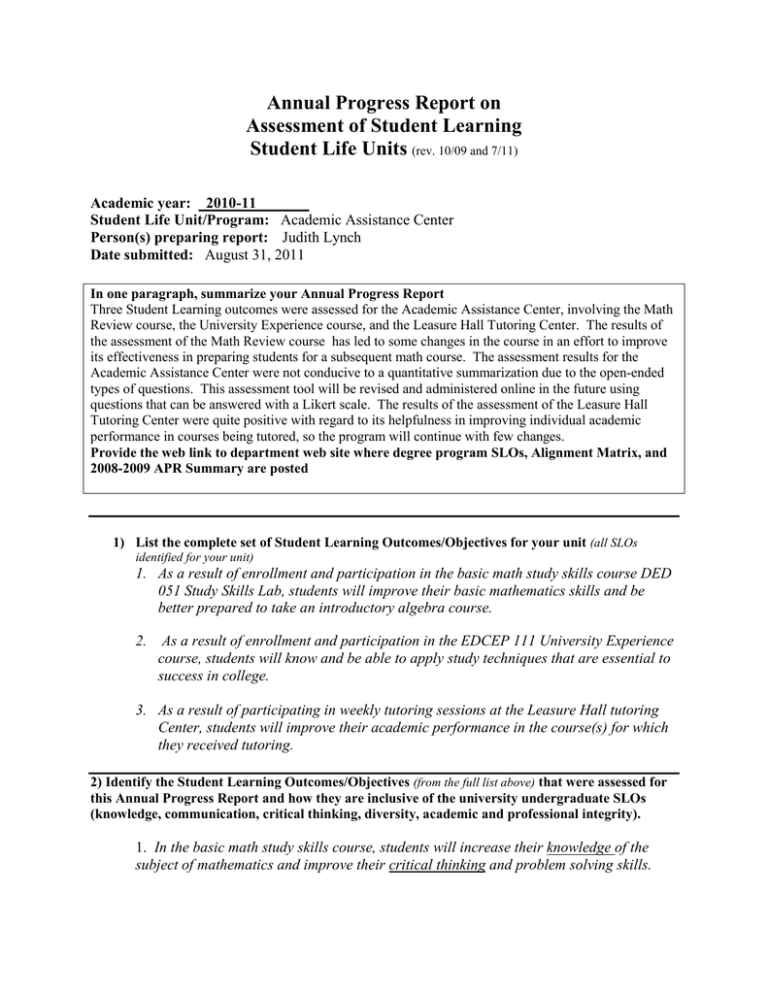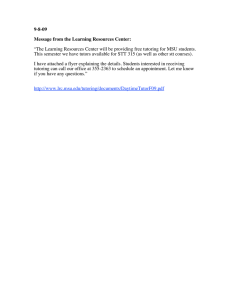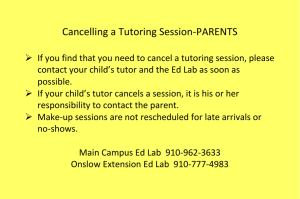Annual Progress Report on Assessment of Student Learning Student Life Units
advertisement

Annual Progress Report on Assessment of Student Learning Student Life Units (rev. 10/09 and 7/11) Academic year: _2010-11_______ Student Life Unit/Program: Academic Assistance Center Person(s) preparing report: Judith Lynch Date submitted: August 31, 2011 In one paragraph, summarize your Annual Progress Report Three Student Learning outcomes were assessed for the Academic Assistance Center, involving the Math Review course, the University Experience course, and the Leasure Hall Tutoring Center. The results of the assessment of the Math Review course has led to some changes in the course in an effort to improve its effectiveness in preparing students for a subsequent math course. The assessment results for the Academic Assistance Center were not conducive to a quantitative summarization due to the open-ended types of questions. This assessment tool will be revised and administered online in the future using questions that can be answered with a Likert scale. The results of the assessment of the Leasure Hall Tutoring Center were quite positive with regard to its helpfulness in improving individual academic performance in courses being tutored, so the program will continue with few changes. Provide the web link to department web site where degree program SLOs, Alignment Matrix, and 2008-2009 APR Summary are posted 1) List the complete set of Student Learning Outcomes/Objectives for your unit (all SLOs identified for your unit) 1. As a result of enrollment and participation in the basic math study skills course DED 051 Study Skills Lab, students will improve their basic mathematics skills and be better prepared to take an introductory algebra course. 2. As a result of enrollment and participation in the EDCEP 111 University Experience course, students will know and be able to apply study techniques that are essential to success in college. 3. As a result of participating in weekly tutoring sessions at the Leasure Hall tutoring Center, students will improve their academic performance in the course(s) for which they received tutoring. 2) Identify the Student Learning Outcomes/Objectives (from the full list above) that were assessed for this Annual Progress Report and how they are inclusive of the university undergraduate SLOs (knowledge, communication, critical thinking, diversity, academic and professional integrity). 1. In the basic math study skills course, students will increase their knowledge of the subject of mathematics and improve their critical thinking and problem solving skills. 2. In the University Experience course, students will gain knowledge regarding the basic academic skills needed for success in college. They will also practice their communication skills, both orally and written, and apply critical thinking skills with regard to career and academic planning. 3. Students who participate in weekly tutoring sessions at the Leasure Hall Tutoring Center will increase their knowledge of the subject in which they are being tutored and learn to apply critical thinking skills to their academic course work. 3) For each learning outcome, describe (a) the measures used (at least one direct measure should be used), (b) the sample of students from whom data were collected, (c) the timetable for the collection, and (d) the forum in which the measures were administered. (Examples of direct measures can be accessed at http://www.k-state.edu/assessment/plans/measures/direct.htm). 1. (a) Students were placed into the Math Review class based on their scores on the Math Placement Exam that is required of all new K-State students as well as their scores on the ACT entrance exam. Students worked through a series of workbooks, taking a pre-test before each workbook. Final grades were based on class participation, homework completed, performance on quizzes and knowledge demonstrated on a final course exam. (b) Fourteen students enrolled in the course and 10 students successfully completed it with a grade of “C” or higher. (c) Students who successfully completed the course in fall 2010 were tracked regarding their performance in a K-State math course during spring 2011 semester. 2. (a) Students enrolled in EDCEP 111 University Experience during the fall 2011 semester were required to assemble a Learning Portfolio of completed assignments. At the end of the semester they were required to analyze their portfolio materials and summarize how their study habits had changed and adapted over the semester. Students also provided feedback through a final course evaluation that included questions such as the following: “How has this class helped you be more successful this semester?” “List three study techniques you learned in this class that you have applied in your other courses.” “How helpful has this course been in improving your study habits.” “Did you do better in your academic coursework as a result of participating in the lab portion of University Experience?” (b) Final course evaluations were voluntarily completed by 76% of the 405students who were in University Experience at the end of the fall semester. (c) The course evaluation was administered during the last week of classes. (d) The evaluation was completed by paper and pencil with open- ended questions. 3. (a) Students who received tutoring were asked to complete a tutor survey at the end of each semester. One of the questions asked was, “Do you feel that working with this tutor has helped you to improve your academic performance in the class for which you received tutoring?” (b) All students who received tutoring were encouraged to complete the survey, but it was not required. There were 436 surveys completed at the end of the fall 2010 semester and 293 surveys completed at the end of the spring semester. (c) The surveys were completed during the last week of classes for both the fall 2010 and spring 2011 semesters. (d) The survey was administered through paper and pencil. 4) Describe the results of the assessment. (What do they tell you about student learning? What did you learn about strengths and weaknesses of your unit?) If specific results are not available, describe the progress that has been made on the initiatives included in the approved assessment plan. 1. Only 7 of the 10 students who successfully complete the Math Review course enrolled in K-State math course the next semester. Six of the students enrolled in MATH 010 Intermediate Algebra, earning one B, one C, two D’s, one F, and one W. The seventh student enrolled in MATH 100 College Algebra and earned a grade of C. This suggests that most students who take the math review class need more instruction in basic math skills then this course is providing. 2. Due to the large number of evaluations and the open-ended nature of the instrument, it was difficult to compile the results into a meaningful summary. 3. In fall 2010 out of 436 respondents, 88.3% felt their academic performance improved as a result of the tutoring, and only .9% felt that it did not improve. The remaining respondents did not answer the question. In spring 2011 out of 293 respondents, 97.3% felt their academic performance improved and 2.7% did not answer the question. This suggests that the tutoring is helping most students to improve their academic performance in the courses for which they are tutored. 5) Describe the actions and/or revisions that were implemented in response to the previous year’s assessment results and the effects on student learning observed on this year’s SLOs. N/A 6) Describe the process by which staff reviewed the results of this year’s SLOs and the actions and/or revisions that are planned in response to the assessment results. (Include changes that may be made to unit SLOs or to the general assessment strategy) 1. Students enrolling in math review had low entrances score exams, as measured by the ACT, and low scores on the Math Placement Exam. Several students had completed their GED rather than graduating from high school. As such, their deficit in math knowledge was extreme. The assessment results indicate that most students did not increase their knowledge of math and /or improve their critical thinking skills as much as needed to be successful in mathematics at the next level. As the result of this assessment, it was decided to double the number of hours the course will meet for the fall 2011 semester to twice a week for two hours. The rationale for this change is that students will have more opportunity to work on problem solving and to receive one-on-one assistance from the instructor. 2. No major changes in the University Experience course were instituted as a result of the evaluations. However, it was determined that a change in the assessment tool is needed for next year. so that the results will be more useful. The instrument will be changed so students can respond using a Likert Scale, and the instrument will be administered online through the Axio system. 3. The tutoring director reviews and summarizes the results of the tutoring survey, and individual tutors are given the results for their students. If a tutor receives low evaluations they may be given additional training or may not be hired again. As a whole, the tutoring seems to be working well and no major revisions will be made in the system. However, the survey will be revised to alert students to the question on the reverse side, which is the one that pertains to improved academic performance. Hopefully this will decrease the number of “no responses” to this question. 7) If needed, revise the department’s Assessment Plan for the next academic year. Attach your assessment plan to this report.


